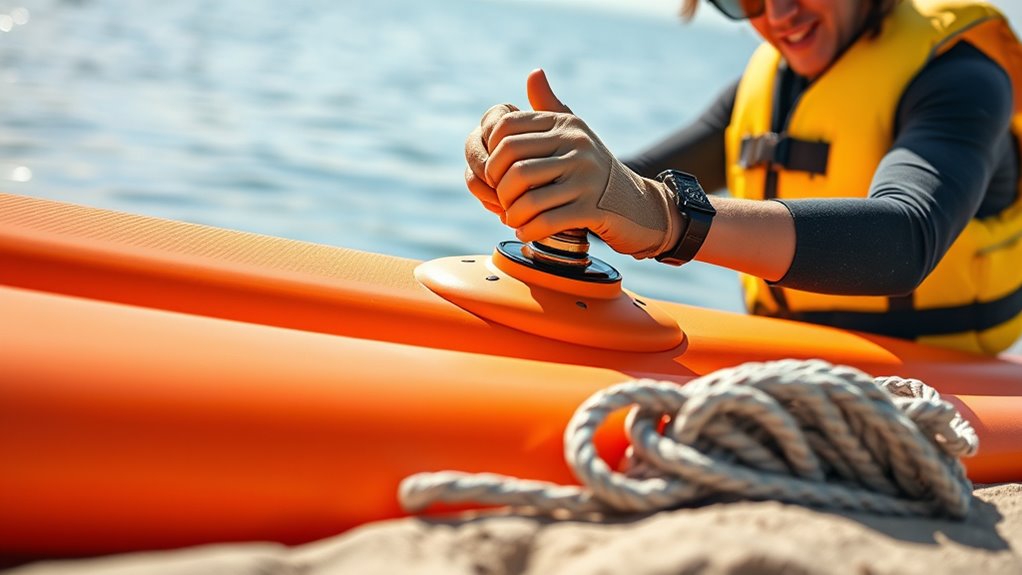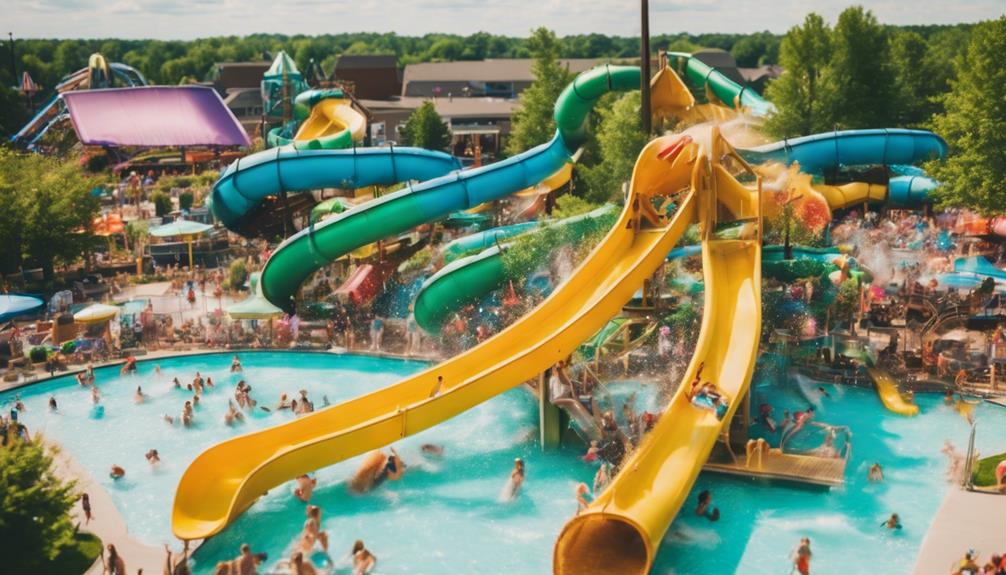Before hitting the water, inspect your inflatable paddlecraft for any damage, tears, or punctures, paying close attention to seams and valves. Confirm it’s properly inflated to the recommended PSI with a secure valve cap, and double-check the safety gear like life jackets, whistles, and lights for proper condition. Examine your paddle and accessories for wear, and review weather conditions to avoid hazards. To stay fully prepared, continue to explore key safety steps for a safe paddle adventure.
Key Takeaways
- Inspect the entire vessel for punctures, tears, and seam integrity; ensure proper inflation to the recommended PSI with secure valves.
- Verify PFD fit, condition, and proper operation of safety gear like whistles, lights, and reflective materials.
- Check paddles and accessories for damage, secure attachments, and readiness for use.
- Review current weather conditions, water hazards, and environmental factors before paddling.
- Conduct routine safety and maintenance checks, including inflation mechanisms and material durability, before each trip.
Inspecting the Vessel for Damage or Defects

Before heading out on the water, you should carefully inspect your inflatable paddlecraft for any signs of damage or defects. Check the entire surface for punctures, tears, or abrasions that could compromise its integrity. Pay close attention to seams, valves, and handles, as these areas are more prone to wear. Look for any discoloration, which might indicate material deterioration. Feel for soft spots or bulges that suggest air leaks or weakened areas. Make certain there are no embedded objects, such as sharp stones or sticks, that could puncture the material. Also, examine the floor and sides for cracks or deformities. Conducting this thorough visual and tactile inspection helps prevent accidents caused by unnoticed damage. Additionally, inspecting the material quality of your paddlecraft ensures it remains durable and safe for use. Regularly checking for noise levels and vibrations can also help identify early signs of wear that might compromise safety. Staying informed about evolving safety standards can help you stay current with best practices and maintenance requirements. Being aware of local regulations and safety guidelines can further enhance your preparedness and safety on the water. Incorporating a comprehensive inspection routine into your preparation process can significantly reduce the risk of unexpected failures. It’s a crucial first step in ensuring your safety on the water.
Verifying the Inflation Level and Valve Security
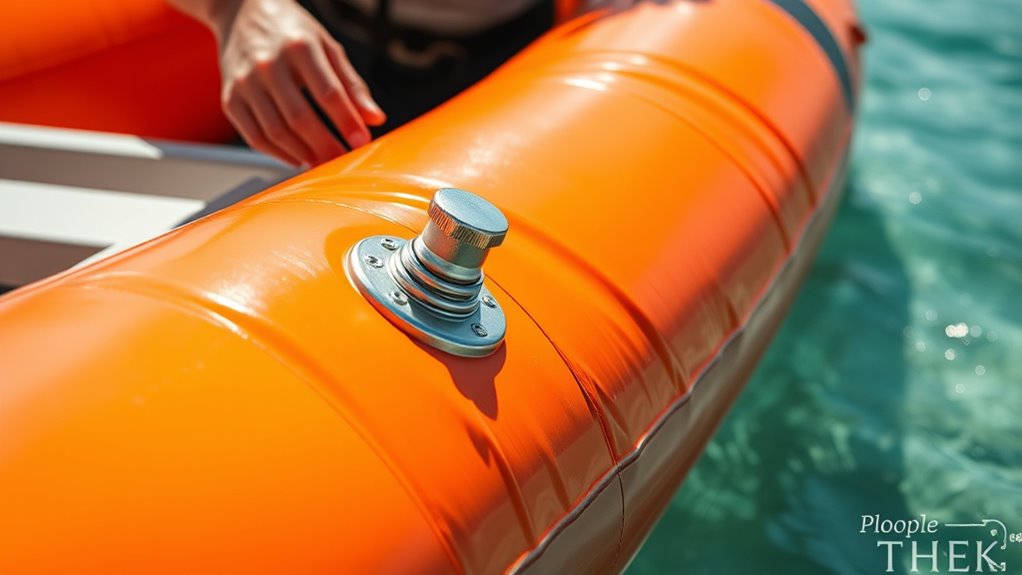
Make sure your paddlecraft is inflated to the recommended pressure to guarantee proper performance and safety. Check that the valve is correctly positioned and securely closed, preventing leaks. Confirm the valve is tight and free of damage before heading out on the water. Additionally, consider inspecting any safety procedures or important milestones related to safety procedures or important milestones to ensure all safety measures are remembered and maintained. Regularly reviewing emergency protocols and safety checks can also help in addressing any unforeseen issues during your water adventures.
Check Recommended Pressure
Ensuring the paddlecraft is inflated to the correct pressure is essential for safety and performance. Use a reliable pressure gauge to verify the recommended PSI listed in your manufacturer’s guidelines. Overinflating can cause seams to burst, while underinflating can lead to instability. Check the valve securely to prevent leaks. To help visualize, consider this table:
| Recommended PSI | Actual PSI | Valve Security | Notes |
|---|---|---|---|
| 10-12 PSI | 11 PSI | Valve firmly closed | Confirm pressure matches guidelines |
| Ensure valve is sealed tightly | |||
| Reinflate if pressure is too low | |||
| Deflate slightly if overinflated |
Always double-check your pressure before heading out. Proper valve security is critical, especially when using inflatable paddlecraft, to prevent leaks and ensure safe use.
Inspect Valve Placement
After verifying the pressure with a reliable gauge, it’s important to inspect the valve placement and security. Confirm the valve is properly seated and flush with the paddlecraft’s surface to prevent leaks. Look for any signs of damage or wear around the valve area. Verify that the valve cap is securely in place; a loose cap can cause air to escape. Check that the valve itself isn’t cracked or broken, as compromised valves can lead to deflation during use. If you notice any irregularities, address them before heading out on the water. Proper valve placement and security are critical for maintaining consistent pressure and ensuring safe, reliable performance of your inflatable paddlecraft. Regularly inspecting inflation mechanisms helps prevent unexpected deflation and prolongs the lifespan of your equipment. Additionally, staying informed about AI-driven solutions in safety technology can enhance your overall paddling experience.
Confirm Valve Tightness
To confirm the valve is secure and the paddlecraft is properly inflated, gently press around the valve area to check for firmness and consistency. If the surface feels soft or uneven, the valve may not be fully tightened or the inflation level is low. Carefully tighten the valve by turning it clockwise, ensuring it’s snug but not over-tightened, which can damage the seal. After tightening, recheck the pressure by pressing gently on different sections of the craft. It should feel firm and consistent throughout. Also, listen for any hissing sounds that might indicate air leaks. Confirming the valve’s security prevents accidental deflation during your trip and ensures your paddlecraft remains safe and buoyant on the water. Proper maintenance of valves and seals is crucial for effective air quality and overall safety. Regularly inspecting the valve seals can help prevent leaks and prolong the lifespan of your inflatable paddlecraft. Incorporating inflation technology can improve the accuracy and ease of maintaining proper pressure levels. Additionally, understanding proper crochet techniques can help in customizing protective covers for your gear to prevent damage during storage or transport, much like the importance of exfoliation for skin health.
Checking Safety Equipment and Personal Flotation Devices
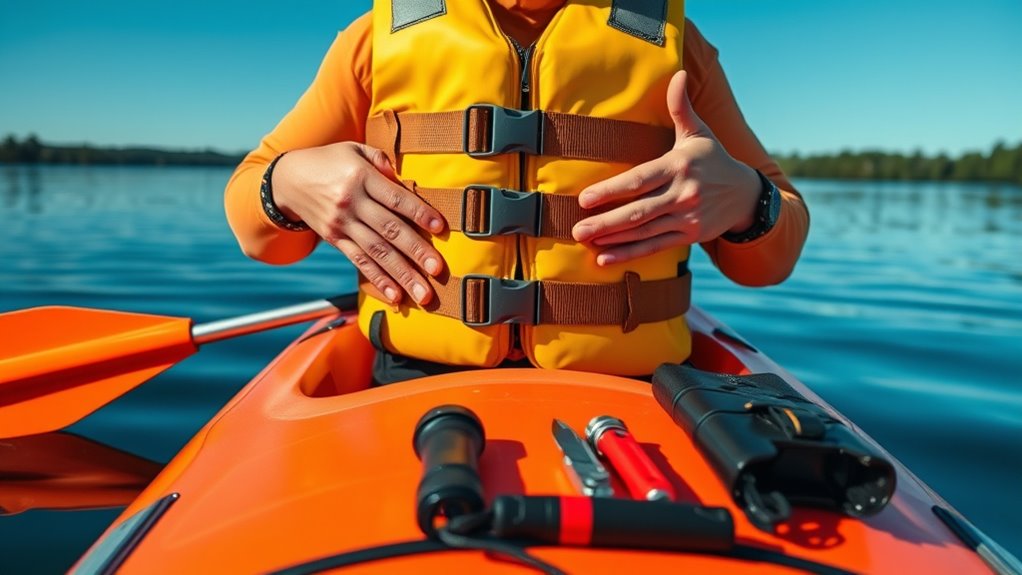
Before heading out, make sure your PFD fits snugly and comfortably, so it stays secure if you need it. Check all safety gear for damage or missing parts, and guarantee emergency equipment is accessible and in working order. Being thorough now can prevent issues and keep you safe on the water. Additionally, ensure that your safety equipment includes appropriate personal flotation devices that are properly maintained and correctly fitted. Regular inspection of your safety equipment is essential to ensure durability and performance in an emergency. Recognizing the importance of emotional and psychological well-being can also help in maintaining a calm and focused mindset during your outing. Incorporating knowledge about equipment compatibility can further enhance your safety measures.
Proper PFD Fit
Ensuring your Personal Flotation Device (PFD) fits properly is essential for safety on the water. A well-fitting PFD should be snug but comfortable, staying in place during movement. It shouldn’t ride up over your chin or ride down over your waist. To check the fit, fasten all straps securely, then lift your arms. The PFD should stay in place without shifting excessively. When you take a deep breath, it should remain snug but not restrict your breathing. If it’s too loose, it won’t provide adequate buoyancy. Conversely, if it’s too tight, it can cause discomfort or restrict movement. Regularly inspect your PFD for wear, tears, or damage, and replace it if needed. Proper fit ensures your safety and confidence while paddling. Incorporating AI-driven safety features into personal flotation devices can further enhance water safety by providing real-time monitoring and alerts. Additionally, selecting a PFD approved by relevant safety standards guarantees that it meets industry safety requirements for reliable performance. Using appropriate materials can also prolong the lifespan of your PFD and maintain its buoyant qualities. Choosing a certified PFD aligned with regulatory standards is crucial for ensuring optimal safety and performance.
Safety Gear Inspection
Regularly inspecting your safety gear is essential for staying prepared on the water. Check your personal flotation device (PFD) for any signs of wear, tears, or deterioration. Guarantee all straps, buckles, and zippers work properly and fit snugly. Make sure your PFD is labeled as Coast Guard-approved and appropriate for your activity. Examine other safety equipment, such as whistles, lights, and reflective materials, to confirm they’re functional and securely attached. Replace any damaged or expired items immediately. Proper maintenance prevents equipment failure during emergencies. Keep your safety gear clean and dry when not in use. Performing regular inspections ensures your gear will perform reliably when needed, providing peace of mind and enhancing your safety on the water.
Emergency Equipment Readiness
Checking your safety equipment and personal flotation devices regularly is essential to guarantee they’re ready when you need them most. Inspect all items for damage, corrosion, or wear, and replace any that are compromised. Ensure your life jackets are in good condition, properly fitted, and easily accessible. Confirm that rescue whistles, signaling devices, and waterproof flashlights are functional and within reach. Test any emergency communication devices to verify they work correctly. Keep a checklist to track your safety gear’s condition and replace expired or damaged items promptly. Being prepared means your equipment will perform reliably during an emergency. Regular checks give you peace of mind, knowing you’re prepared to respond quickly and effectively if the unexpected happens on the water.
Examining the Paddle and Other Accessories

Before heading out on the water, take a close look at your paddle and accessories to make certain everything is in top condition. Check your paddle for any cracks, splinters, or warping, and ensure the blade is securely attached. Inspect any straps, clips, or bungee cords on your gear for signs of wear or damage, replacing them if needed. Make sure your paddle’s handle is intact and comfortable to grip. If you have a leash or safety strap, verify it’s securely fastened and functional. For accessories like pumps, repair kits, or waterproof bags, examine for leaks, tears, or broken components. Properly maintained equipment not only prolongs its lifespan but also guarantees reliable performance and your safety while on the water.
Reviewing Weather and Water Conditions
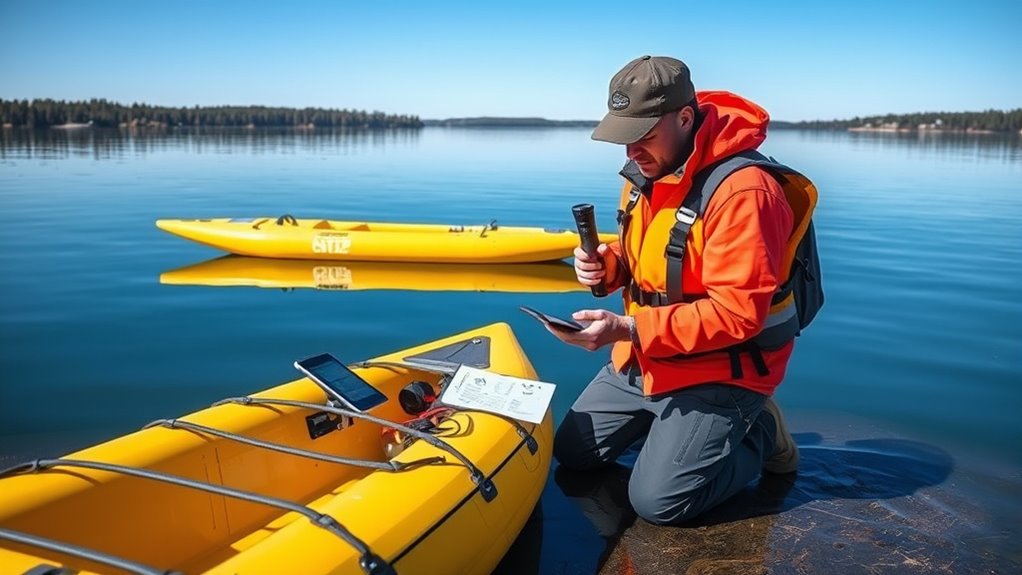
Have you reviewed the current weather and water conditions before heading out? Checking the forecast helps you avoid dangerous situations like strong winds, storms, or sudden temperature drops. Look for updates on wind speeds, wave heights, and water temperature, as these factors directly impact your safety and paddling experience. Pay attention to any weather alerts or warnings in your area, especially if conditions change quickly. Be mindful of water currents, tides, and potential hazards like rocks or submerged objects that could be affected by weather changes. If conditions seem risky, postpone your trip or choose a calmer location. Staying informed guarantees you can enjoy your paddle safely and respond promptly if the weather shifts unexpectedly.
Planning Your Route and Sharing Your Trip Details

Planning your route carefully and sharing your trip details are essential steps to guarantee safety on the water. Know where you’ll go, including landmarks and potential hazards, before launching. Share your planned route, estimated start and end times, and contact info with a trusted person. This way, someone knows your whereabouts and can alert authorities if needed. Use the table below to organize your trip details:
| Trip Details | Information |
|---|---|
| Departure Location | |
| Estimated Return Time | |
| Route Description | |
| Emergency Contacts | |
| Special Considerations | (e.g., currents, obstacles) |
Having clear plans and sharing them minimizes risks and ensures help arrives if you encounter trouble. Stay informed, prepared, and communicate your plans effectively.
Conducting a Final Safety Briefing Before Launch

Conducting a final safety briefing before launch is a crucial step to guarantee everyone on board understands the plan and stays safe. You should review the route, highlighting any potential hazards like shallow areas or strong currents. Make sure everyone knows how to communicate during the trip, whether through hand signals or waterproof radios. Confirm that all safety gear is in place, including life jackets, whistles, and repair kits. Clarify procedures for emergencies, such as capsizing or injuries, so everyone feels prepared. Encourage questions to clear up any uncertainties. Keep the briefing concise but thorough, emphasizing safety priorities. This step ensures everyone is aligned, confident, and ready for a safe, enjoyable paddlecraft adventure.
Frequently Asked Questions
How Often Should I Perform Safety Checks on My Inflatable Paddlecraft?
You should perform safety checks on your inflatable paddlecraft before every trip to guarantee it’s in good condition. Regular inspections help catch any tears, leaks, or damage that could compromise safety. Additionally, check the valve, inflation level, and any attachments or accessories. Doing these checks consistently helps prevent accidents and keeps your paddling experience enjoyable. Make it a routine to maximize safety and peace of mind on the water.
What Are Common Signs of Hidden Damage on an Inflatable Vessel?
Imagine a calm lake hiding secrets beneath its surface. Hidden damage on your inflatable vessel isn’t always obvious; look for small, sudden bubbles or air leaks, which indicate weak spots. Examine seams closely for fraying or peeling, and check for discoloration or soft spots that suggest internal damage. Always inspect the exterior thoroughly, as these subtle signs can prevent unexpected deflation or failure while you’re out enjoying your paddlecraft.
How Do I Properly Store My Inflatable Paddlecraft to Prevent Damage?
To properly store your inflatable paddlecraft, you should first clean it thoroughly and let it dry completely to prevent mold. Deflate it fully and fold or roll it carefully, avoiding sharp creases. Store it in a cool, dry place away from direct sunlight and extreme temperatures. Keep it in a protective bag or cover to prevent dust and damage. This helps extend its lifespan and keeps it ready for your next adventure.
Are There Specific Safety Considerations for Different Water Conditions?
Imagine you’re paddling in a calm lake versus choppy coastal waters. In calmer conditions, you can focus on comfort and stability, but in rougher waters, you need extra caution. Always check local weather forecasts, avoid strong currents, and wear a life jacket. Adjust your paddling technique to suit water conditions, and stay close to shore if you’re unsure. Your safety depends on understanding and respecting the water’s behavior.
What Should I Do if Safety Equipment Gets Damaged During Use?
If your safety equipment gets damaged during use, you should stop paddling immediately and assess the damage. Remove the equipment from your gear, and if possible, repair it using appropriate methods or replace it entirely. Never continue using damaged safety gear, as it may not protect you effectively. Always carry spare safety equipment or repair kits, and guarantee you’re familiar with how to fix or replace gear quickly for your safety.
Conclusion
Think of your inflatable paddlecraft as a trusty steed ready for adventure. By performing these safety checks, you’re saddle-ing up for a smooth ride, steering clear of hidden pitfalls. With each inspection, you’re laying down the foundation for a safe journey, like sharpening your sword before battle. When you respect these precautions, you’re not just paddling—you’re setting out on a well-prepared voyage, turning potential storms into calm waters. Safe travels, brave explorer!

